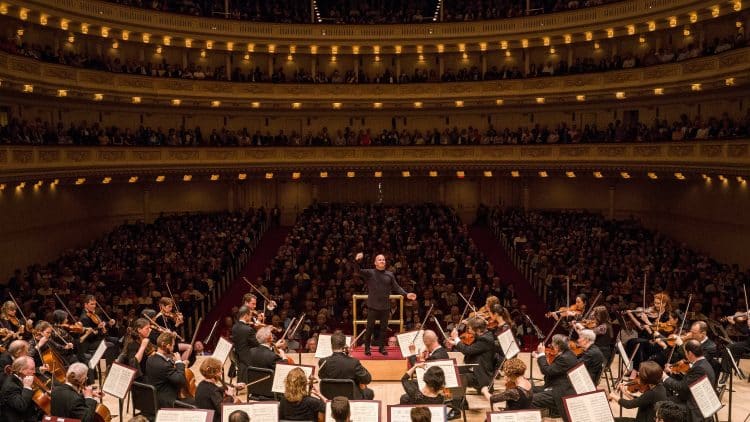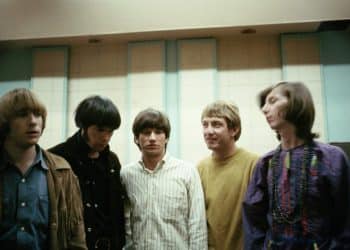Classical music has withstood the test of time, captivating audiences for centuries with its timeless melodies, intricate harmonies, and emotional depth. In this article, we embark on a journey through the rich tapestry of classical music to uncover the top 15 pieces that have left an indelible mark on the genre. From the grandeur of symphonies to the intimacy of solo piano works, each composition selected for this list represents a pinnacle of artistic achievement and has earned its place as a beloved masterpiece. These pieces transcend cultural and temporal boundaries, resonating with listeners across generations and continents. Whether you are a seasoned aficionado or a newcomer to the world of classical music, this curated selection offers a comprehensive overview of the genre’s most iconic and influential works. Prepare to be transported to different eras and landscapes, as we explore the genius of composers such as Ludwig van Beethoven, Wolfgang Amadeus Mozart, and Johann Sebastian Bach, among others. From the celestial beauty of “Clair de Lune” by Claude Debussy to the stirring majesty of Beethoven’s “Symphony No. 9,” each composition on this list showcases the remarkable diversity and depth of classical music. As we delve into the history and significance of each piece, we will uncover the stories behind the notes, exploring the cultural, social, and personal contexts that shaped these masterworks. Whether you seek solace in the delicate strains of a Mozart sonata or exhilaration in the thunderous crescendos of a Tchaikovsky symphony, the top 15 classical music pieces featured in this article promise to ignite your imagination, stir your emotions, and leave an enduring impression on your soul.
1. Symphony No. 5 by Ludwig van Beethoven
Ludwig van Beethoven’s Symphony No. 5 stands as an iconic masterpiece in the realm of classical music, earning its place as one of the top best classical music pieces of all time. Composed between 1804 and 1808, it is often referred to as the “Fate Symphony” due to its famous four-note motif that permeates the entire work, creating a sense of destiny and triumph. The symphony is celebrated for its dramatic and compelling nature, with each movement seamlessly flowing into the next, showcasing Beethoven’s unparalleled ability to convey powerful emotions through music. The thunderous opening motif in the first movement and the triumphant finale with its exhilarating coda have become universally recognizable, leaving an indelible mark on the classical music landscape.
Beethoven’s Symphony No. 5 is not merely a musical composition; it is a testament to the composer’s resilience and triumph over adversity. Written during a tumultuous period in Beethoven’s life marked by personal challenges and the onset of deafness, the symphony reflects his determination to overcome obstacles. The relentless drive and emotional depth found in Symphony No. 5 resonate with audiences across generations, making it a timeless masterpiece that continues to captivate and inspire listeners worldwide.
2. The Four Seasons by Antonio Vivaldi
Antonio Vivaldi’s “The Four Seasons” stands as a pinnacle of Baroque music and is revered as one of the top best classical music pieces of all time. Composed in the early 1720s, this collection of four violin concertos – “Spring,” “Summer,” “Autumn,” and “Winter” – vividly captures the essence of each season through rich orchestration and evocative melodies. Vivaldi’s ingenuity lies in his ability to paint aural landscapes, portraying chirping birds, gentle breezes, thunderstorms, and crisp winter scenes with remarkable precision. The virtuosic solo violin parts, particularly in the opening of “Spring” and the frenetic finale of “Summer,” showcase Vivaldi’s mastery of both composition and performance.
“The Four Seasons” not only showcases Vivaldi’s technical prowess but also demonstrates his innovative approach to programmatic music. The concertos were accompanied by sonnets, possibly written by Vivaldi himself, providing poetic descriptions that guide the listener through the unfolding narrative of each season. The enduring popularity of “The Four Seasons” lies in its universal appeal, transcending time and cultural boundaries. Its influence can be heard in various adaptations, reimaginings, and performances across genres, making it a timeless masterpiece that continues to enchant and resonate with audiences around the globe.
3. Eine kleine Nachtmusik by Wolfgang Amadeus Mozart
Wolfgang Amadeus Mozart’s “Eine kleine Nachtmusik,” translated as “A Little Night Music,” is a jewel in the crown of classical music and secures its position as one of the top best classical music pieces of all time. Composed in 1787, this serenade for strings exemplifies Mozart’s exceptional melodic gift and compositional prowess. The piece is characterized by its effervescent charm, elegant structure, and delightful interplay of instruments. From the sparkling Allegro to the tender Romanze and the buoyant Menuetto, each movement encapsulates a distinct mood, showcasing Mozart’s ability to craft music that is both intellectually engaging and emotionally resonant.
“Eine kleine Nachtmusik” stands as a testament to Mozart’s seemingly effortless ability to create enduring masterpieces. The serenade’s enduring popularity lies in its timeless appeal, as its graceful melodies and spirited rhythms continue to captivate listeners across generations. The composition has found its way into numerous cultural contexts, from concert halls to film soundtracks, cementing its status as a classical gem that transcends the boundaries of time and genre. Mozart’s genius shines through in this serenade, creating a musical experience that is both accessible and profound, making “Eine kleine Nachtmusik” an indispensable part of the classical repertoire.
4. The Marriage of Figaro by Wolfgang Amadeus Mozart
Wolfgang Amadeus Mozart’s opera “The Marriage of Figaro” stands as a pinnacle of classical operatic achievement, securing its place as one of the top best classical music pieces of all time. Premiered in 1786, the opera is based on Pierre Beaumarchais’s comedic play and showcases Mozart’s exceptional ability to blend intricate vocal lines with a rich and expressive orchestral score. The libretto, penned by Lorenzo Da Ponte, weaves a tale of love, intrigue, and social satire, as the characters navigate a complex web of relationships and societal hierarchies. Mozart’s music is a masterful interplay of wit, drama, and lyrical beauty, creating an operatic experience that is both intellectually stimulating and emotionally engaging.
“The Marriage of Figaro” is celebrated for its impeccable ensemble writing, intricate vocal ensembles, and memorable arias. From the playful overture to the sublime Act II finale, Mozart’s genius is evident in the opera’s ability to seamlessly balance humor and depth. The work’s enduring popularity lies in its universal themes and timeless exploration of the human condition. Mozart’s score not only complements the comedic elements of the plot but also elevates the opera to a level of artistic sophistication that has resonated with audiences for centuries. “The Marriage of Figaro” remains a cornerstone of the operatic repertoire, enchanting audiences with its musical brilliance and insightful social commentary.
5. Moonlight Sonata by Ludwig van Beethoven
Ludwig van Beethoven’s “Moonlight Sonata,” officially known as Piano Sonata No. 14 in C-sharp minor “Quasi una fantasia”, Op. 27, No. 2, holds a revered place as one of the top best classical music pieces of all time. Composed in 1801, this sonata is a testament to Beethoven’s revolutionary approach to composition. The first movement, known for its hauntingly beautiful and expressive melody, has earned the nickname “Moonlight” due to its evocative, tranquil character. Beethoven’s use of dynamics, delicate phrasing, and the exploration of the piano’s tonal range contribute to the sonata’s enduring emotional impact.
The “Moonlight Sonata” is a prime example of Beethoven’s ability to convey profound emotions through music. The introspective first movement is followed by contrasting lively and energetic sections, showcasing Beethoven’s dynamic range and innovative approach to form. The sonata’s enduring popularity stems from its ability to evoke a wide range of emotions, making it a timeless masterpiece that continues to captivate listeners. Its influence extends far beyond the classical realm, with adaptations and references in various genres, cementing its place as a transcendent work that resonates across musical landscapes.
6. Ride of the Valkyries by Richard Wagner
Richard Wagner’s “Ride of the Valkyries,” from his opera “Die Walküre,” emerges as a powerful and iconic composition that stands among the top best classical music pieces of all time. Composed in the mid-19th century as part of Wagner’s epic four-opera cycle “Der Ring des Nibelungen,” this exhilarating orchestral piece captures the valiant and thunderous ride of the Valkyries, warrior maidens of Norse mythology. The composition is marked by its triumphant brass fanfares, driving strings, and dynamic orchestration, creating an intense and dramatic musical narrative.
The “Ride of the Valkyries” has transcended the opera stage to become a cultural phenomenon, recognized and celebrated beyond classical music circles. Its spirited and energetic theme has permeated popular culture, finding its way into films, television, and even commercials, cementing its status as one of the most recognizable and influential classical compositions. Wagner’s ability to evoke a sense of grandeur and heroism in this piece has contributed to its enduring popularity, making it a cornerstone of classical music repertoire and a symbol of dramatic power in the world of orchestral music.
7. Canon in D by Johann Pachelbel
Johann Pachelbel’s “Canon in D” holds a timeless and cherished place as one of the top best classical music pieces of all time. Composed around 1680, this Baroque masterpiece is renowned for its simple yet elegant beauty. The piece unfolds as a canon, a musical form where a melody is imitated and overlapped by different voices, creating a mesmerizing and harmonically rich texture. Pachelbel’s “Canon in D” is characterized by its graceful progression of chords and the soothingly repetitive nature of the canon structure, providing a sense of tranquility and emotional depth.
The enduring appeal of “Canon in D” lies in its universal accessibility and emotional resonance. Its gentle, flowing melody has found its way into countless weddings, films, and popular arrangements, making it a beloved piece across diverse audiences. Pachelbel’s composition showcases the beauty that simplicity can achieve, proving that a well-crafted melody and harmonious structure can leave a profound impact. As a result, “Canon in D” stands as a testament to the enduring power of music to evoke emotions and create a lasting connection with listeners, securing its status as a classical gem that continues to captivate and inspire.
8. William Tell Overture by Gioachino Rossini
Gioachino Rossini’s “William Tell Overture” stands as a dynamic and exhilarating composition, earning its place among the top best classical music pieces of all time. Composed in 1829 for his opera “Guillaume Tell” (William Tell), the overture is a masterful orchestral showcase that encapsulates the drama and excitement of the entire opera. This piece is celebrated for its iconic fanfare, rhythmic precision, and memorable melodies, including the famous “Lone Ranger” theme that has become synonymous with heroism and adventure.
The “William Tell Overture” is a prime example of Rossini’s compositional brilliance, characterized by its use of contrasting sections, vivid orchestration, and rhythmic intensity. The piece takes the listener on a thrilling journey, from the serene pastoral scenes to the galloping hooves and stirring crescendos of the final section. Rossini’s ability to convey a vivid narrative and evoke a wide range of emotions within a concise orchestral work contributes to the overture’s enduring popularity.
The piece has transcended its operatic origins to become a cultural phenomenon, prominently featured in various films, television shows, and commercials. Rossini’s “William Tell Overture” remains a captivating and iconic work that continues to captivate audiences with its energy, brilliance, and evocative power.
9. Flight of the Bumblebee by Nikolai Rimsky-Korsakov
Nikolai Rimsky-Korsakov’s “Flight of the Bumblebee” is a dazzling and virtuosic orchestral interlude that has secured its position among the top best classical music pieces of all time. Originally composed as part of Rimsky-Korsakov’s opera “The Tale of Tsar Saltan” in 1899-1900, this brief but frenetic piece is renowned for its rapid-fire, chromatic passages that vividly evoke the buzzing and darting of a bumblebee. The composition has become synonymous with technical brilliance and has been widely adapted for various instruments, showcasing the performer’s agility and precision.
“Flight of the Bumblebee” is a remarkable showcase of Rimsky-Korsakov’s skill in orchestration and his ability to create vivid musical imagery. The relentless and rapid nature of the music presents a formidable challenge for performers, making it a popular choice for musicians seeking to display their technical prowess. Despite its brevity, the piece’s enduring popularity lies in its ability to captivate listeners with its high-energy intensity and the thrilling sensation of flight. Rimsky-Korsakov’s musical depiction of a bumblebee in rapid motion remains a captivating and iconic work that continues to astonish and entertain audiences across the globe.
10. Adagio for Strings by Samuel Barber
Samuel Barber’s “Adagio for Strings” is a poignant and emotionally resonant composition that has rightfully earned its place among the top best classical music pieces of all time. Composed in 1936, the piece was originally the second movement of Barber’s String Quartet, Op. 11, before he later arranged it for string orchestra. The “Adagio for Strings” is celebrated for its profound and evocative beauty, with a melodic richness that elicits a deep emotional response.
The hauntingly expressive nature of the “Adagio for Strings” has made it a powerful and versatile work, finding a place in various cultural and artistic contexts. Barber’s use of string instruments creates a sense of intimacy and vulnerability, allowing the music to convey a wide range of emotions, from melancholy to transcendent beauty. The piece has been utilized in films, television, and commemorations, becoming an emblematic representation of mourning and reflection.
Barber’s “Adagio for Strings” stands as a timeless expression of human emotion, capturing the essence of sorrow and hope in its delicate yet powerful notes. Its enduring popularity lies in its ability to connect with listeners on a profoundly emotional level, making it a poignant and unforgettable contribution to the classical music repertoire.
11. Brandenburg Concertos by J.S. Bach
Johann Sebastian Bach’s “Brandenburg Concertos” is a set of six instrumental works that collectively stand as a pinnacle of Baroque craftsmanship, solidifying their status among the top best classical music pieces of all time. Composed around 1721 and dedicated to the Margrave of Brandenburg, the concertos showcase Bach’s innovative approach to orchestration and his mastery of counterpoint. Each concerto presents a unique combination of instruments and explores a diverse range of styles, from spirited dance movements to contemplative slow sections.
The “Brandenburg Concertos” are revered for their virtuosity, intricate interplay between instruments, and the sheer brilliance of Bach’s musical invention. Concerto No. 3, with its energetic Allegro, stands out for its exuberant and joyful character, while Concerto No. 6, scored without violins and featuring a distinctive timbre with lower strings, offers a captivating contrast. Bach’s ability to blend various instruments seamlessly, creating intricate dialogues and harmonies, reflects his unparalleled skill as a composer.
The enduring appeal of the “Brandenburg Concertos” lies in their timeless beauty, intellectual depth, and the sheer joy they bring to listeners. Bach’s innovative approach to concerto writing in this collection has secured its place as a cornerstone of the Baroque repertoire, continuing to captivate and inspire musicians and audiences alike across centuries.
12. Swan Lake by Pyotr Ilyich Tchaikovsky
Pyotr Ilyich Tchaikovsky’s “Swan Lake” stands as a pinnacle of classical ballet music, securing its place among the top best classical music pieces of all time. Composed in 1875-76, the ballet features a spellbinding score that complements the tragic and romantic narrative of enchanted swans and forbidden love. Tchaikovsky’s exquisite melodies and emotive orchestrations are on full display, creating an enduring masterpiece that has become synonymous with the art of classical ballet.
The “Swan Lake” score is characterized by its evocative use of leitmotifs, transporting listeners into the enchanted world of Prince Siegfried and the Swan Queen, Odette. The expressive and captivating themes, such as the iconic “Swan Theme,” showcase Tchaikovsky’s ability to convey the full range of human emotions through music. The ballet’s lush orchestrations, including the use of the celesta in the “Dance of the Little Swans,” contribute to the magical and otherworldly atmosphere.
Tchaikovsky’s “Swan Lake” has transcended the confines of the ballet stage, becoming a beloved and widely recognized piece in the broader classical music repertoire. Its enduring popularity is a testament to Tchaikovsky’s ability to create music that not only enhances the visual spectacle of ballet but also stands alone as a masterful composition capable of resonating with audiences on a profound emotional level.
13. Nessun dorma by Giacomo Puccini
Giacomo Puccini’s “Nessun dorma” from the opera “Turandot” is a breathtaking aria that has rightfully earned its place among the top best classical music pieces of all time. Composed in 1926, Puccini’s final opera features this aria as its climactic moment. Sung by the character Calaf, “Nessun dorma” translates to “None shall sleep,” and it encapsulates the tenor’s fearless determination to win the heart of the ice-cold Princess Turandot.
The aria is celebrated for its powerful and emotionally charged melody, with Puccini’s orchestration heightening the intensity of Calaf’s declaration of love. The famous high B note, held with dramatic fervor, adds to the aria’s iconic status. “Nessun dorma” has transcended the opera stage to become a cultural phenomenon, embraced by audiences far beyond the realm of classical music. Its triumphant and anthemic qualities have led to numerous renditions in popular culture, including sports events, commercials, and film soundtracks.
Puccini’s “Nessun dorma” remains a testament to the composer’s ability to craft emotionally resonant and universally appealing music. Its enduring popularity lies in the aria’s ability to evoke passion, determination, and the triumphant victory of love, making it a timeless gem that continues to captivate audiences around the world.
14. Nuages gris by Franz Liszt
Franz Liszt’s “Nuages gris,” translated as “Gray Clouds,” is a haunting and introspective piano composition that secures its place among the top best classical music pieces of all time. Composed in 1881, this short yet impactful work is part of Liszt’s late period, characterized by his exploration of unconventional harmonic language and emotive expression. “Nuages gris” is a departure from Liszt’s more virtuosic compositions, offering a brooding and atmospheric piece that anticipates the moodier, impressionistic styles of the 20th century.
The title aptly captures the essence of the composition, as Liszt weaves a melancholic tapestry of harmonies that evoke a sense of gloom and introspection. The sparse and dissonant chords create an enigmatic and mysterious atmosphere, allowing listeners to immerse themselves in a world of emotional complexity. “Nuages gris” stands as a testament to Liszt’s ability to innovate and evolve as a composer, showcasing a departure from the flamboyant and dramatic style for which he was known.
Despite its brevity, “Nuages gris” remains a captivating and thought-provoking piece in the piano repertoire. Liszt’s exploration of tonal ambiguity and atmospheric effects in this composition foreshadows the developments in 20th-century music, making it a significant work that continues to intrigue and resonate with audiences and performers alike.
15. Gymnopédies by Erik Satie
Erik Satie’s “Gymnopédies” stand as ethereal and contemplative piano compositions that have secured their place among the top best classical music pieces of all time. Composed in the late 19th century, specifically in 1888, these three short works are characterized by their spare and atmospheric quality, reflecting Satie’s desire to create music that was devoid of the emotional excesses prevalent in the Romantic era.
The “Gymnopédies” are marked by their gentle, repetitive melodies and subtle harmonic shifts, creating an impressionistic and meditative atmosphere. Satie’s use of unconventional tempo markings, such as “Lent et douloureux” (Slow and sorrowful) for the first piece, contributes to the unique and contemplative nature of the compositions. The simplicity and beauty of the “Gymnopédies” have made them enduringly popular, influencing later composers and finding a place in various artistic forms, including film and dance.
Satie’s “Gymnopédies” remain a masterful example of the composer’s avant-garde approach to music, breaking away from traditional structures and embracing a more introspective and evocative style. Their delicate charm and tranquil allure continue to captivate audiences, making the “Gymnopédies” an essential and timeless contribution to the world of classical music.









